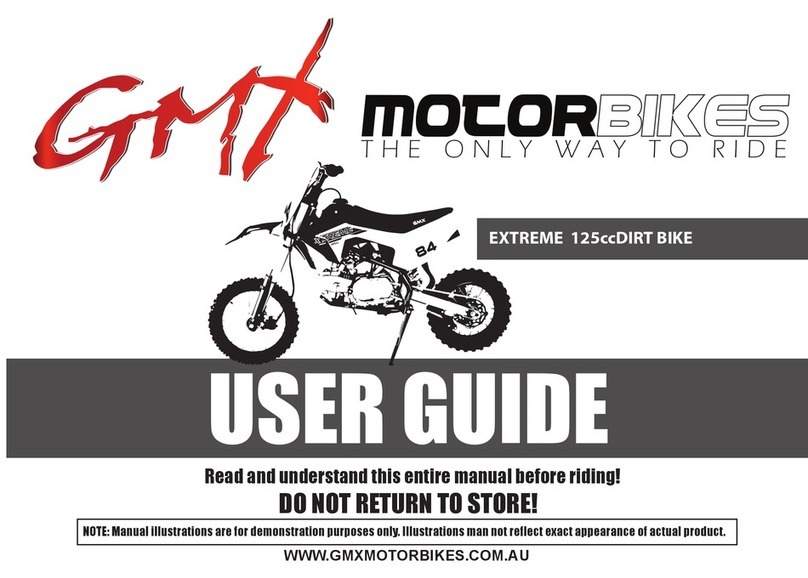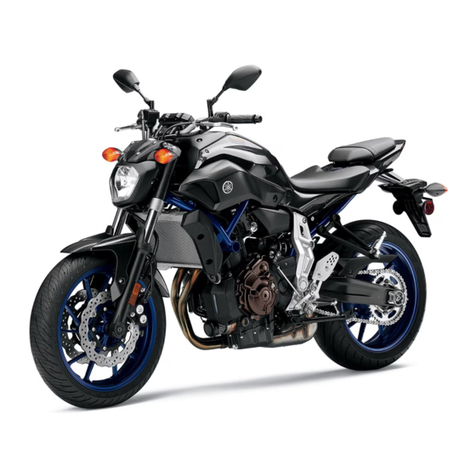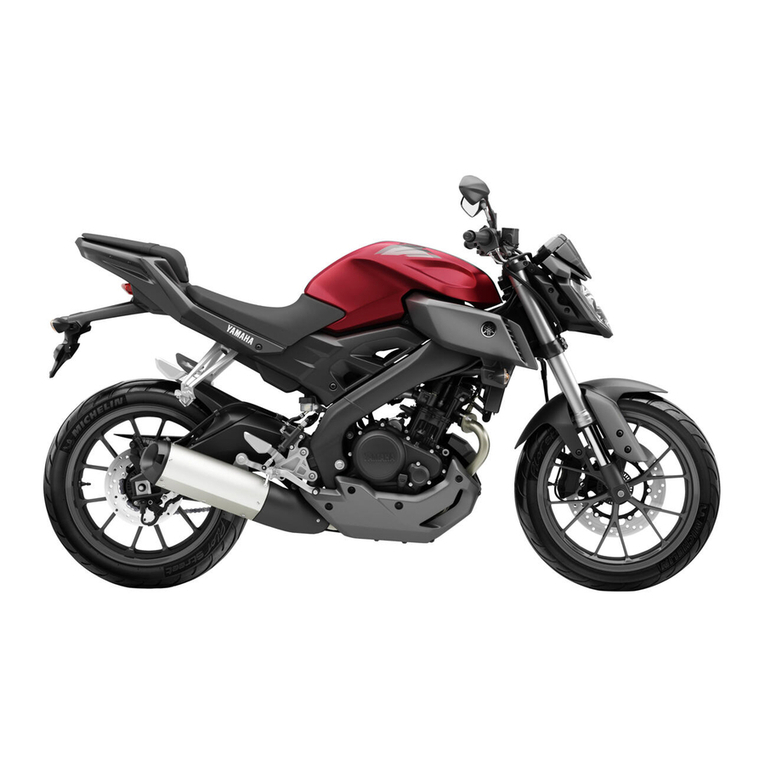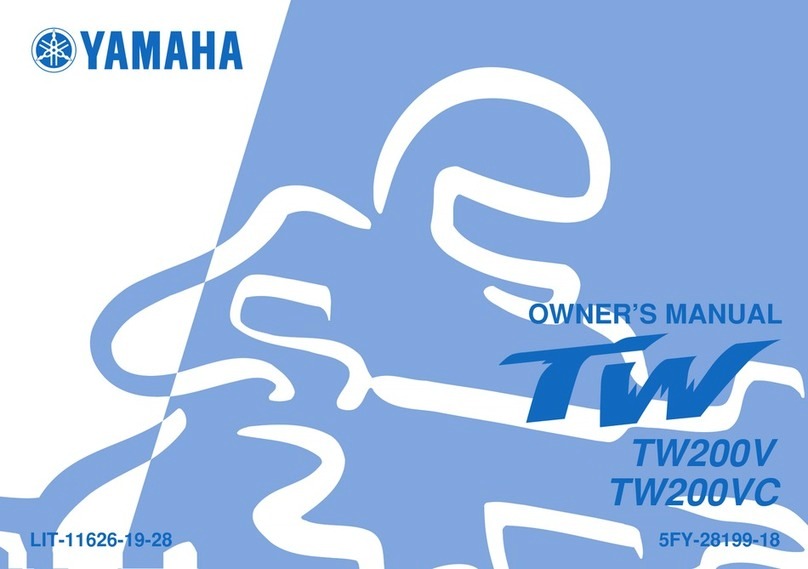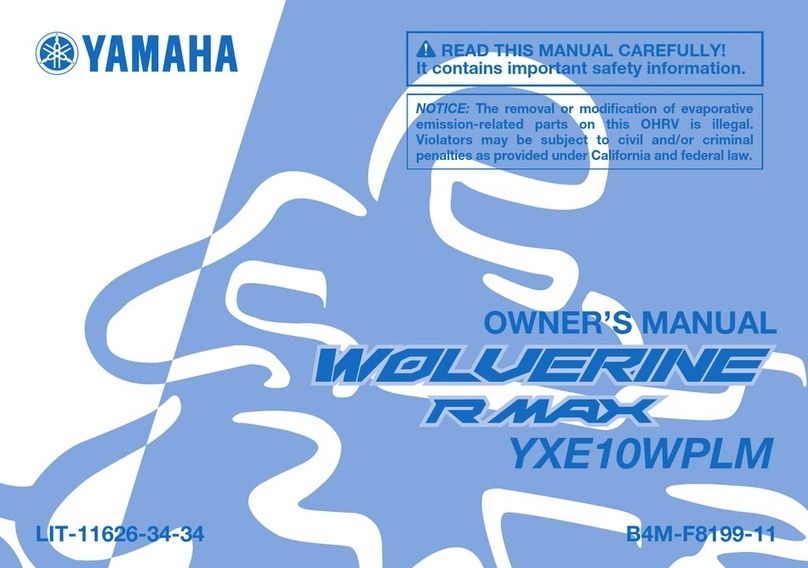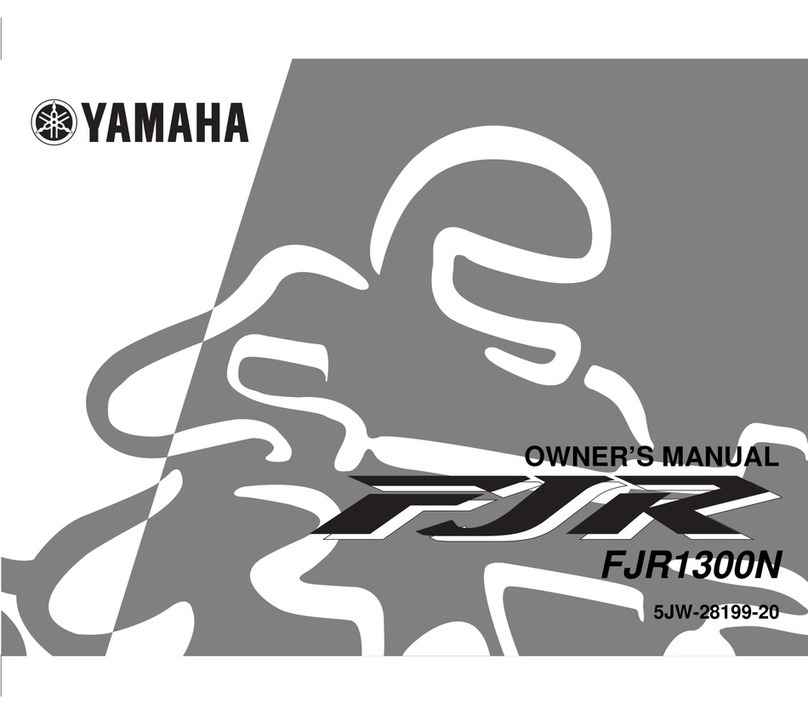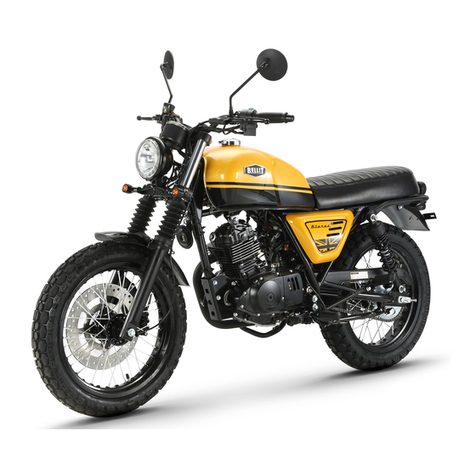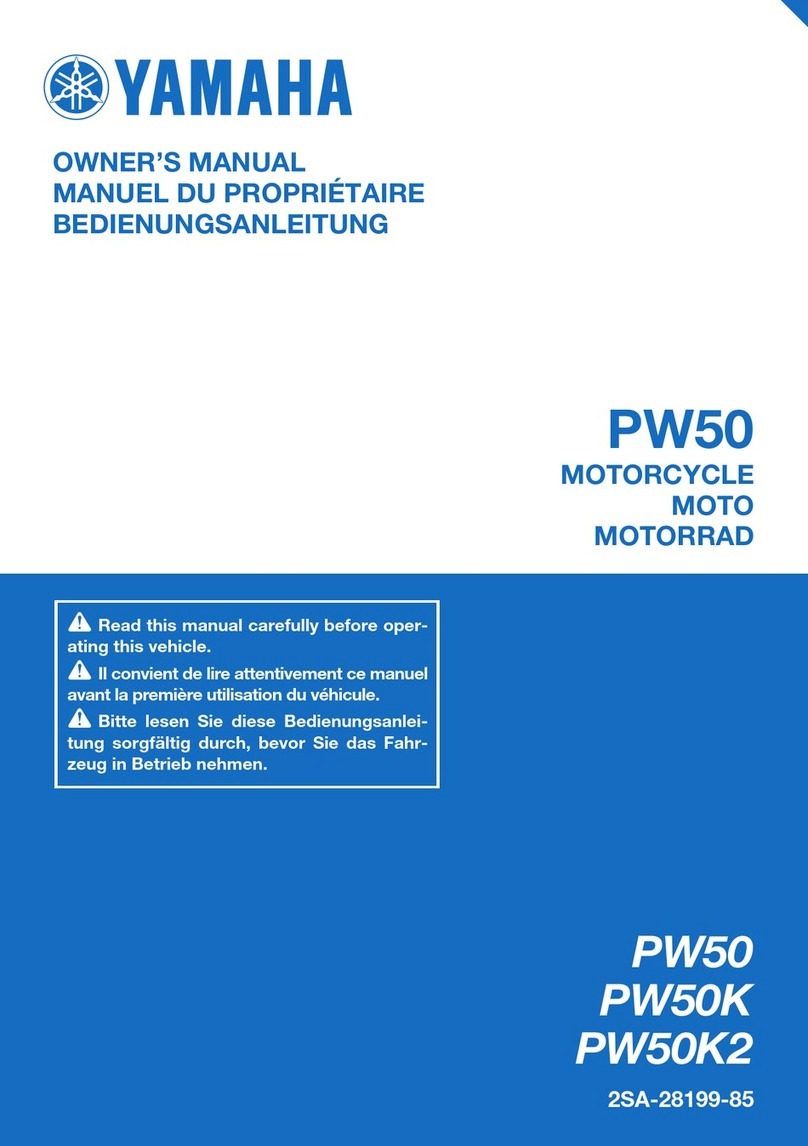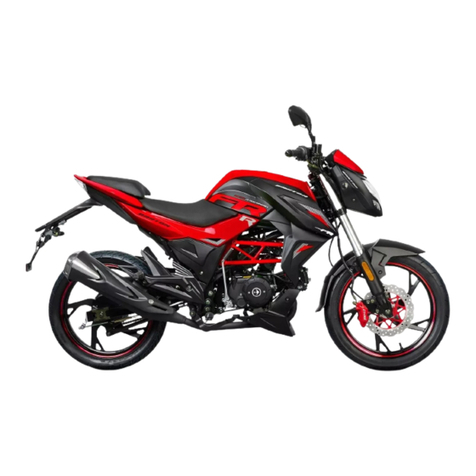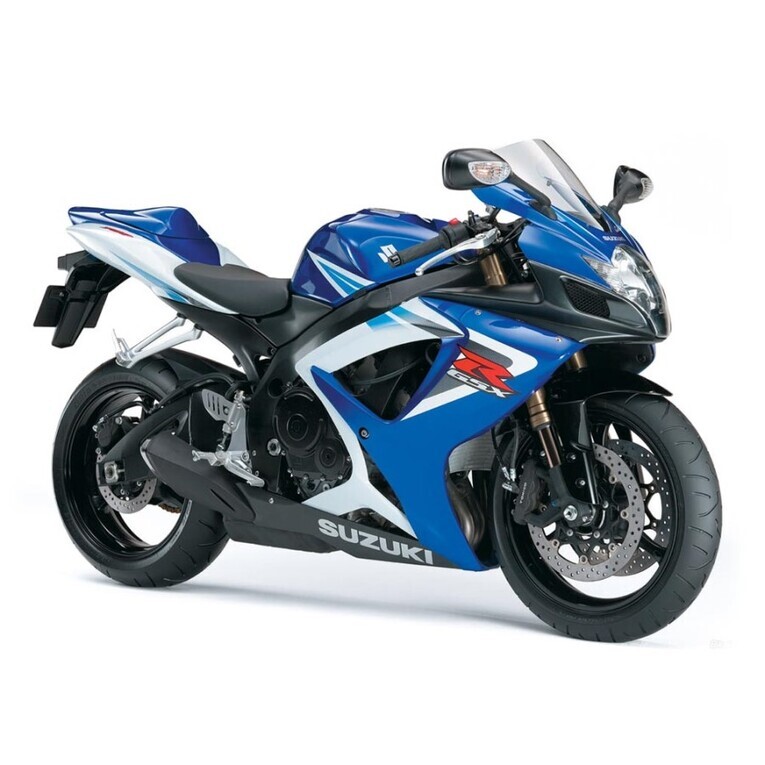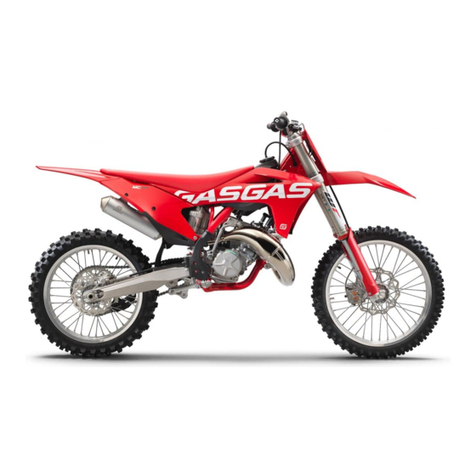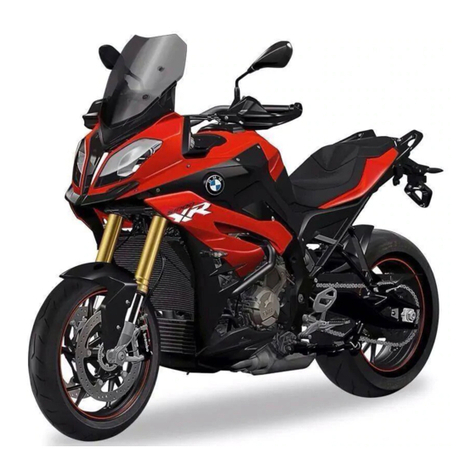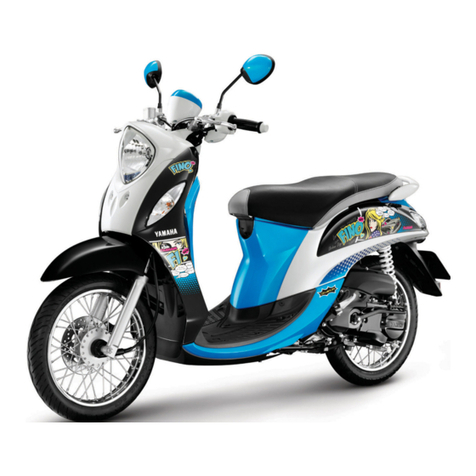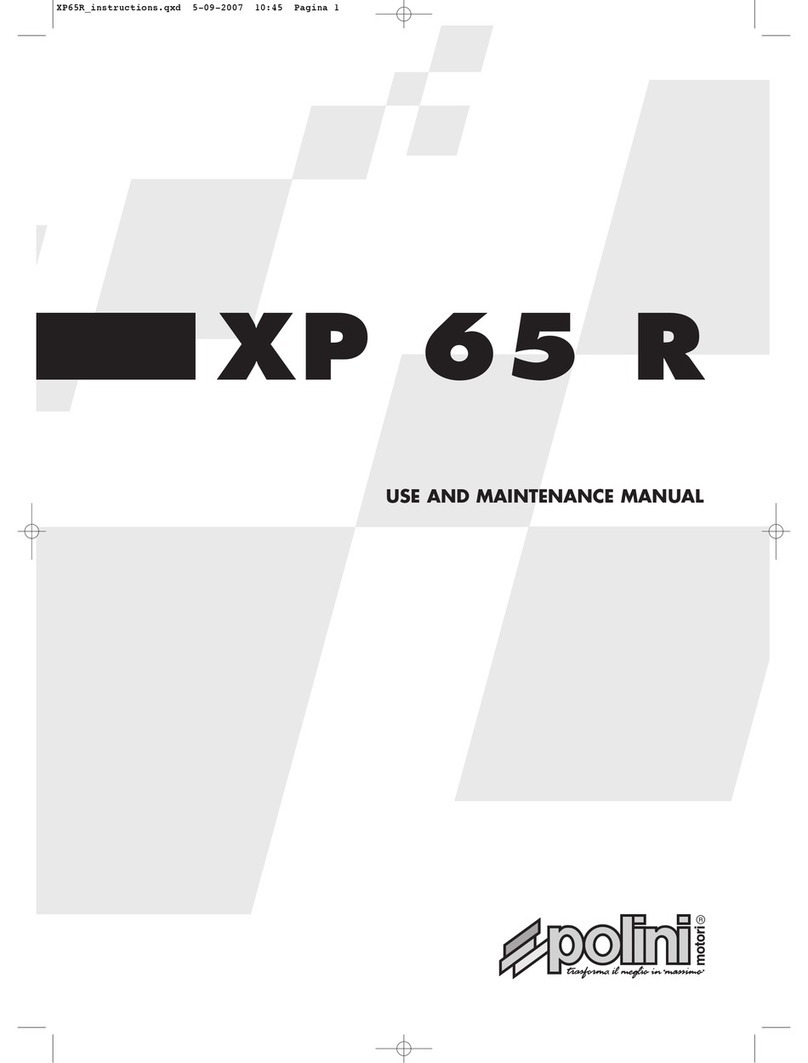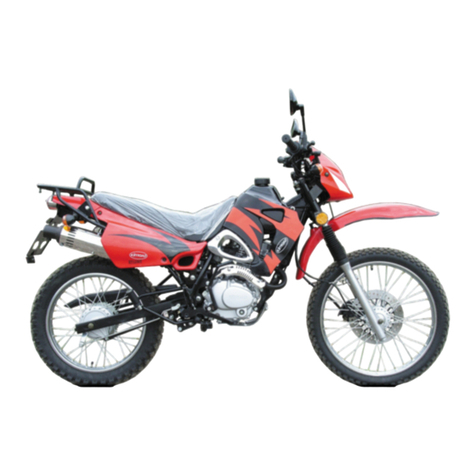GMX MOTORBIKES X Series User manual

ASSEMBLY MANUAL
Read and understand this entire manual before riding!
DO NOT RETURN TO STORE!
NOTE: Manual illustrations are for demonstration purposes only. Illustrations man not reflect exact appearance of actual procduct.
WWW.GMXMOTORBIKES.COM.AU
PH: 1300 766 469 | Chrisco Support: www.gmxmotorbikes.com.au/chriscosupport
GMX X-SERIES DIRT BIKE 50cc | 150cc | 250cc

CONGRATULATIONS ON YOUR GMX PURCHASE!
This assembly guide covers basic step by step instructions to assist you with the assembly process.
Products are always subject to further improvement, which will cause some dierence between vehicle and this manual,
without further notice. We wish you happy riding.
UNPACKING
Please CAREFULLY remove all external box and metal frame packaging
TIP: These parts can be sharp so when unpacking the packaging hand with caution.
CHECK LOOSE PARTS
On most occasions your bike will come 90% assembled (depending on the model). Please go through all lose parts and check
packaging that has been taken out, to ensure no parts get thrown out so you can assemble your GMX Product.
READ MANUAL
Ensure that you read and go over the manual and UNDERSTAND before assembling product.
PLEASE NOTE: Minor assembly is required, but in the interest of safety it is recommended that you have this bike assembled
by a skilled bike mechanic.
TO DOWNLOAD YOUR COMPLETE OWNER’S MANUAL GUIDE PLEASE VISIT http://www.gmxmotorbikes.com.au/download-centre

CHECK BRAKES
ARE ADJUSTED
CORRECTLY PRIOR
TO RIDING.
YOU MUST CHECK
THAT THE CHAIN
IS ADJUSTED
CORRECTLY PRIOR
TO RIDING.
PLEASE READ AND UNDERSTAND ALL INSTRUCTIONS AND WARNINGS PRIOR TO ASSEMBLY AND OPERATING OF YOUR VEHICLE.
Swing tags have been placed on your vehicle for you to identify checks that are located within this manual. Once you have performed the
check required remove these swing tags and nylon loops attaching them to the vehicle.
MAKE SURE TO REMOVE THE SWING TAGS AND TAKE SPECIAL NOTICE TO REMOVE THE NYLON LOOP.
The tags and loops that need to be removed from this model.
ONCE SWING TAGS AND NYLON LOOPS ARE REMOVED YOU ARE ACKNOWLEDGING THAT THESE
CHECKS HAVE BEEN PERFORMED
There may be a“Spare Parts Package”within the carton so please check all of the packaging
and DO NOT THROW OUT
WARNINGS
SWING TAG’S & WARNINGS
BRAKE ADJUSTMENT x2CHAIN ADJUSTMENT
ALWAYS LEAVE IN
THE OFF POSITION
WHEN NOT IN USE
OR REMOVE KEYS
KEY REMOVAL
WARNING
Please use unleaded fuel
90 Octane or above
UNLEADED FUEL ONLY
WARNING: This product is powered by a 4 stroke engine and comes with transport oil in the engine.
THE OIL NEEDS TO BE DRAINED AND REPLACED WITH MOTORCYCLE OIL 10W/40 or 10W/50 IS REQUIRED
IF THE OIL CHANGE IS NOT PERFORMED YOU MAY INTERNALLY DAMAGE THE ENGINE AND CLUTCH AND VOID YOUR WARRANTY
DO NOT USE MOTOR CAR OIL
DO NOT USE OIL WITH FRICTION MODIFIERS
OIL WILL NEED TO BE CHANGED EVERY 3 MONTHS IN A HOTTER CLIMATE OR THE NOTHERN HEMISPHERE
- There is an oil drain plug located underneath you quad/dirt bike and is highlighted with an oil drain plug sticker. This is a 14mm bolt.
- DO NOT remove the other bolt located under the engine.
- Place an oil receptacle under the drain hole, undo bolt and let oil drain from the vehicle. Please note: Dispose of oil correctly
- Tighten bolt back up, remove dipstick (oil ll point) and ll the vehicle with suggested correct amount of oil required. Tighten
TO AVOID DAMAGE TO GEARBOX AND
MOTOR. WHEN SELECTING GEAR AND
CHANGING GEARS, RELEASE THE
THROTTLE. DO NOT USE EXCESSIVE
FORCE ON GEAR LEVER.
GEAR LEVER

GMX MOTORBIKES WARRANTY
Our goods come with guarantees that cannot be excluded under the Australian Consumer Law. You are entitled to a replacement or refund for a major
failure and compensation for any other reasonably foreseeable loss or damage. You are also entitled to have the goods repaired or replaced if the goods
fail to be of acceptable quality and the failure does not amount to a major failure.
The manufacturer warrants this product to be free of manufacturing defects for a period of 12 months from date of purchase. This Limited Warranty does
not cover normal wear and tear( exclusions apply) or any damage, failure or loss caused by improper assembly, maintenance, or storage or use of the GMX
product. Some parts will have a limited warranty period, please see below. This warranty is a part replacement warranty.
3 Month Parts Replacement Parts
Electrical components, suspension, drive train and brakes/ttings.
30 Days Parts Replacement Parts
Bearings, tires, tubes, cables, clutches, brake pads, seats
Minor assembly is required and in the interest of safety and warranty it is recommended that you have this product assembled by a qualied, skilled small
engine mechanic.
You may need to provide proof of being assembled by a skilled mechanic if not a report from a small engine mechanic advising of the issues to process
your warranty claims.
The warranty is a parts replacement warranty and labor is not included, defective parts may need to be sent back for inspection.
This Limited Warranty will be void if the product is ever;
- Used in a manner other than for recreation or transportation
- Modied in anyway
- Rented or commercial use.
The manufacturer is not liable for incidental or consequential loss or damage due directly or indirectly to the use of this product.
Always adhere to the maximum load of the product, over loading the product will void the warranty.
How a claim is made
When making a claim, you will need to provide proof of purchase, condition photos of the item. This information is required to be submitted via the
support center and communication is made through the support center. When the claim is created, the customer will receive the claim number and the
customer support team should reply within 48 hours.

This section presents some of the most important information and recommendations to help you ride your motorcycle safely.
Please take a few moments to read these pages. This section also includes a special message for parents and location information for the safety labels on your
motorcycle. Your motorcycle can provide many years of service and pleasure—if you take responsibility for your own safety and understand the challenges you can
meet while riding.
This motorcycle has been designed for younger riders. However, not all younger riders are physically or emotionally ready to ride. Therefore before any parents allow
any youngster to ride this motorcycle, we urge them to read the Important Message to Parents beginning and the Parents, Youngsters and O-Road Motorcycles booklet.
There is much you can do to protect yourself when you ride. You’ll nd many helpful recommendations throughout this manual. The following are a few that we
consider most important.
Ride O-Road Only. Your motorcycle is designed and manufactured for o-road use only. The tires are not made for pavement, and the motorcycle does not have turn
signals and other features required for use on public roads. If you need to cross a paved or public road, get o and walk your motorcycle across.
TAKE TIME TO LEARN AND PRACTICE
Developing o-road riding skills is a gradual, step-by-step process. Start by practicing at low speeds in a safe area and slowly build your skills. Personal instruction
from an experienced rider can also be valuable.
ALWAYS WEAR A HELMET
It's a proven fact: helmets signicantly reduce the number and severity of head injuries. It is required to wear an Australian Motorcycle Standard Helmet when
riding a motor bike. So always wear an approved motorcycle helmet. We also recommend that you wear eye protection, sturdy boots, gloves, and other protective gear.
NEVER CARRY A PASSENGER
Your motorcycle is designed for one person only. There are no handholds, footrests, or seat for a second person—so never carry a passenger. A passenger could
interfere with your ability to move around to maintain your balance and control of the motorcycle.
BE ALERT FOR HAZARDS
The terrain can present a variety of challenges when you ride o-road. Continually "read" the terrain, for unexpected turns, drop-os, rocks, ruts, and other hazards.
Always keep your speed low enough to allow time to see and react to hazards.
RIDE WITHIN YOUR LIMITS
Pushing limits is another major cause of motorcycle accidents. Never ride beyond your personal abilities or faster than conditions warrant. Remember that alcohol,
drugs, fatigue, and inattention can signicantly reduce your ability to make good judgments and ride safety.
IMPORTANT SAFETY INFORMATION

IMPORTANT SAFETY INFORMATION
DON’T DRINK AND RIDE
Alcohol and riding don't mix. Even one drink can reduce your ability to respond to changing conditions, and your reaction time gets worse with every additional drink.
So don't drink and ride, and don't let your friends drink and ride either.
KEEP YOUR DIRT BIKE IN A SAFE CONDITION
It's important to keep your motorcycle properly maintained and in safe riding condition.
Having a breakdown can be dicult, especially if you are stranded o-road far from your base. To help avoid problems, inspect your motorcycle before every ride and
perform all recommended maintenance.
That's why we urge you to read this message before you let any young person ride this motorcycle. O-road riding can be fun. But, as with riding a bicycle, bad judgment
can result in injury, and we don't want that to happen! As a parent, you can help prevent accidents by making good decisions about if, when, and how your youngster
rides this motorcycle.
RIDING READINESS
The rst decision you'll need to make is whether your youngster is ready to ride. Riding readiness varies widely from one person to another, and age and size are not
the only factors. For example, riders must be big enough to hold the motorcycle up, get on, and comfortably sit on the seat with both feet touching the ground.
They should also be able to easily reach and work the brakes, throttle, and all other controls. ATHLETIC ABILITY is necessary for riding a motorcycle. Generally speaking,
your youngster should be good at riding a bicycle before getting on a motorcycle. Can your youngster judge speeds and distances while riding a bicycle and react with
proper hand and foot actions? Anyone who does not have good coordination, balance, and agility is not ready to ride this motorcycle.
To help your youngster build condence as they're learning to ride, this bike was delivered with a speed restrictor that limits top speed. We recommend that all beginning
riders start o with the speed restrictor may be adjusted to gradually increase maximum speed as the beginner becomes more familiar with riding their bike/motorcycle.
INSTRUCTION AND SUPERVISION
If you decide that your youngster is ready to safely operate this motorcycle, make sure both of you carefully read and understand the owner's manual before riding.
Also be sure that your youngster has a helmet and other appropriate riding equipment and always wears it when operating the vehicle or sitting it.
SUPERVISION is another important obligation of parents. Even after youngsters have become skilled o-road riders, they should always ride with adult supervision.
It helps to regularly remind young riders of basic safety rules and precautions. And remember, it's your responsibility to see that the motorcycle is properly maintained
and kept in safe operating condition
SAFE AND RESPONSIBLE RIDING must be an on-going commitment—by you and your youngster. When you both put safety rst, you can enjoy more peace of mind, and
your youngster can enjoy more hours of safe o¬ road riding.

For your convenience, this DIRT BIKE comes with an ignition switch and key. Remove the key when the motorcycle is parked to help prevent unauthorized use.
Your Dirt Bike was designed as a rider-only motorcycle. It was not designed to carry a passenger or cargo. A passenger or cargo could interfere with your ability to move
around to maintain your balance and control of the motorcycle.
In addition, exceeding the weight limits or carrying an unbalanced load can seriously aect your motorcycle's handling, braking, and stability. Adding accessories or
making modications that change this motorcycle's design and performance can also make it unsafe. Also, the weight of any accessories will reduce the maximum load
the motorcycle can carry.
LOAD LIMITS
Following are the load limits for your motorcycle:
Maximum weight capacity = 50 KG’s
Includes the weight of the rider and any accessories.
CHECK ALL LOOSE PARTS - Check and secure all nuts and bolts BEFORE EVERY RIDE. Make sure the handle bars and their clamp are tight to unsure no movement
and are locked into place. There should be no unusual shakes or noises associated with loose or broken parts. If you are unsure, get advised by an experienced small
engine mechanic or hobby shop technician.
BRAKE CHECK - Check the brakes for correct functioning. When you apply pressure to the hand brake you should have a positive braking action. If not adjust the brake
accordingly. When you apply the brake with the accelerator on the brake cut-o switch will stop the motor.
FRAME, FORK AND HANDLEBARS - Check for cracks in the frame or broken connections. A broken frame is very rare but in some cases when aggressive riders run into
a gutter can break a frame. Make sure the check is done regularly.
TYRE INFLATION - Check the tyres for excessive wear and always check the pressure and re-inate if required. If you get a at tyre you will need to replace the inner tube
and are available to purchase from GMX
SAFETY GEAR - Always wear a motorbike Australian standard helmet and protective gear such as elbow pads, knee pads, gloves and enclosed shoes. Never ride barefoot
or in thongs.
THROTTLE - Check the free play and adjust if needed. Rotate the throttle to make sure it moves smoothly without sticking, and snaps shut automatically when it is
released, in all steering positions.
BRAKES - Squeeze the front brake lever and step on the rear brake pedal to check that the controls operate normally. Adjust free play, if necessary.
IMPORTANT SAFETY INFORMATION

5
IMPORTANT NOTES ABOUT SAFETY
(1) All nuts/bolts/spokes need to be tightened before, during and after use.
(2) The chain has to be adjusted correctly.
(3) The swing-arm has to be checked and tightened before, during and afteruse.
(4) Please note if the above points are not done, it will lead to misalignment, causing the chain to comeoff.
WARRANTY
The dirt bikes are sold as off-road or enduro competition motorcycles and they will require a high level of
care and maintenance.
The dirt bikes, due to their intended purpose being competition motorcycles, become the same class as a
competition rally car. Therefore it is up to the individuals to establish which level of bike they need to buy
to perform the relevant tasks in which they intend to use it.

6
MAINTENANCE
Proper maintenance is necessary to ensure that your motorcycle will continue to have low emission levels.
Those items identified by the periodic maintenance chart are necessary to ensure compliance with the
applicable standards.
The owner of this motorcycle has the responsibility to maintain their vehicle according to the instructions
in this owner’s manual.
You should keep a maintenance record for your motorcycle. Pages are provided in the rear of this manual.
TAMPERING WITH NOISE CONTROL SYSTEM PROHIBITED
Specific laws may prohibit the following acts or the causing there of: (1) the removal or rendering
inoperative by any person other than for purposes of maintenance, repair or replacement, of any device or
element of design incorporated into any new vehicle for the purpose of noise control prior to its sale
delivery to the ultimate purchaser or while it is in use, or (2) the use of the vehicle after such device or
element of design has been removed or rendered inoperative by any person. Among those acts presumed
to constitute tampering are the acts listed below:
•
Replacement of the original exhaust system or silencer with a component not in compliance with
manufacturer’s original specifications.
•
Removal of the silencer(s) or any internal portion of the silencer(s).
•
Removal of the air filter, air box or air box cover.
•
Modifications to the silencer(s) or air intake system by cutting, drilling, or other means of such
modifications result in increased noiselevel.

7
TABLE OF CONTENTS
GENERAL INFORMATION ...................................
Location of parts .................................................
Fuel .....................................................................
Fuelrequirements..............................................
Engine kill switch ................................................
Starting the engine .............................................
Moving off ..........................................................
Changing gear .....................................................
Stopping the motorcycle ....................................
Daily pre-ride checks ..........................................
Break-in period ...................................................
MAINTENANCE AND ADJUSTMENT ...................
Maintenance general.........................................
Periodic maintenance chart ...............................
Engineoil............................................................
Spark plug ...........................................................
Valve clearance ..................................................
Air filter ..............................................................
Throttle grip .......................................................
Carburetor ..........................................................
8
8
10
11
12
13
14
15
15
16
17
18
18
20
22
25
26
27
28
30
Drive chain ..........................................................
Handlebar ...........................................................
Brakes .................................................................
Front brake pad replacement .............................
Rear brake pad replacement ..............................
Steering ...............................................................
Front and rear suspension ..................................
Wheels and tyres ................................................
Spokes and rims ..................................................
Tightening torques of nuts and bolts ..................
Cleaning of your motorcycle ...............................
Lubrication ..........................................................
STORAGE ............................................................
ASSEMBLY ...........................................................
MAINTENANCE RECORD ....................................
TROUBLE SHOOTING GUIDE ..............................
31
31
32
33
34
36
37
38
38
39
42
44
45
46
49
58

8
GENERAL INFORMATION
Location of parts
1. Clutch lever
2. Fuel tank cap
3. Front brake lever
4. Engine kill switch
5. Handlebar
6. Throttle grip

9
GENERAL INFORMATION
7. Brake hose
8. Front fork
9. Fuel tap
10. Drive chain
11. Swing arm
12. Front brake disc
13. Front brake caliper
14. Left tank fin
15. Choke lever
16. Gear lever
17. Engine oil drainplug
18. Air filter
19. Chain guide
20. Silencer
21. Seat
22. Fuel tank
23. Right tank fin
24. Rear brake disc
25. Rear brake caliper
26. Rear shock
27. Kick start
28. Rear brake pedal
29. Engine guard
30. Carburetor

10
GENERAL INFORMATION
Fuel cap
To open the fuel tank cap (A), turn the tank cap
counter clockwise.
Avoid filling the tank in the rain or where heavy
dust is blowing so that the fuel does not get
contaminated.
Fuel tap
The fuel tap has two positions: ON (A) and OFF (B).
For normal operation turn the fuel tap to the ON
position.
Turn the fuel tap lever to the OFF position when
the fuel tank is removed for maintenance and
adjustments or when the motorcycle is left unused
for lengthy periods.

11
GENERAL INFORMATION
⚠
WARNING
Petroleum is extremely flammable and can be
explosive under certain conditions. Always stop
the engine and do not smoke. Make sure the
area is well ventilated and free from any source
of flame or sparks; this Includes any appliance
with a pilot light. After refuelling, make sure the
fuel tank cap is closed securely. If petrol is
spilled on the fuel tank, wipe It off immediately.
Fuel Requirements:
Fuel type
Use clean, fresh unleaded petrol with a
minimum research octane number (RON) 95.
The RON is posted on fuel station pumps in
Europe, The octane rating of a gasoline is a
measure of its resistance to detonation or
‘knocking’ The antiknock index is an average of
the Research Octane Number (RON) and the
motor Octane number (MON)
CAUTION
If engine ‘knocking’ or ‘pinging’ occurs, use a
different brand of petrol of a higher octane
rating.
If this Condition is allowed to continue it can lead
to severe engine damage.
Petrol quality is important. Fuels of low quality or
not meeting standard industry specification may
result in unsatisfactory performance. Operating
problems that result from the use of poor quality
or non recommended fuel may not be covered
under your warranty.
CAUTION
Before storage it is recommended that you drain all
fuel from the tank and carburetor, See the storage
section in this manual.

12
GENERAL INFORMATION
Engine kill switch
The engine kill switch is located on the left side
of the handlebar. This can be used for the
normal engine shutdown or emergency engine
shutdown. Hold the switch pushed in until the
engine stops (type A) or pushed to the in
position (type B)
Starting the engine
Shift the transmission into neutral by
pushing the shift pedal down into neutral
until the motorcycle rolls freely. (140cc plus
will start in gear with the clutch engaged
fully).
Turn the fuel tap to the ON position.
Turn the ignition key to the ON position if
your motorcycle is fitted with one.
Ensure your kill switch is not pressed in
(type B).

13
Starting the engine
Choke
Starting the engine
Electric start models
GENERAL INFORMATION
With cold engines, use the carburetor
choke lever (A), lift upwards for choke ON.
Warm engine before riding.
Move choke lever downwards when the
engine is warm for choke OFF.
Pull in the front brake lever, then press
the start button located on the left
side of the handlebar.
Kick start can be used as a backup if
required.

14
GENERAL INFORMATION
Starting the engine
Kick start
Using your foot, push the kick start (A)
downwards with speed.
Moving off
Geared models
Engage clutch fully.
Shift into 1st gear.
Open the throttle slowly.
Release the clutch slowly.
Automatic models
Open the throttle slowly.
Note
When the engine is already warm or on a hot
day, open the throttle part way instead of
using the choke lever.

15
GENERAL INFORMATION
Shifting gears
Close the throttle completely.
Engage the clutch fully.
Shift into the next higher or lower gear.
Release the clutch fully.
Open throttle again.
Stopping the motorcycle
For maximum deceleration, close the throttle and
apply both front and rear brakes. Independent use
of the front or rear brake may be advantageous in
certain circumstances. Shift down progressively to
ensure good engine response at all speeds.
4 Speed 5 Speed
4- 5-
3- 4-
2- 3-
1- 2-
N- N-
1-
⚠
WARNING
When shifting down into a lower gear, do not
shift at such a high speed that the engine r/min
(rpm) jumps excessively. Not only can this cause
engine damage, but the rear wheel may skid and
cause an accident.
CAUTION
When changing gears, raise or press firmly on
the gear lever to ensure proper shifting.
Careless, incomplete shifting can cause the
transmission to jump out of gear and will lead to
engine damage.

16
GENERAL INFORMATION
Daily pre-ride checks
Check the following items each day before you ride. The time requirement is minimal, and habitual performance of these checks
will help ensure a safe reliable ride.
If any irregularities are found during these checks, refer to the appropriate section and take the action required to return the
motorcycle to a safe operating condition.
⚠
WARNING
Failure to perform these checks every day before you ride may result in serious damage or a severe accident.
Engine
Engine oil
Spark plug
Carburetor
Air filter
Silencer
Frame
Tyres
Spokes
Drive chain
Brakes
Throttle
Steering
Fuel tank
Engine kill switch
Nuts, bolts, fasteners
Check engine oil level correct. No leakage.
Tighten to correct torque.
Adjusted properly –idle speed: 1400 ± 100 r/min (rpm).
Clean, properly installed, apply oil to air filter element.
Check not damaged.
Check overall condition; wear, cuts and other damage, check tyre air pressure, tighten the air
valve cap securely.
Check for any loose spokes, if necessary tighten.
Check overall condition, lubricate the drive chain, check drive chain tension is correct and
adjust if necessary.
Check front and rear brakes function properly.
Brake lever play is 4-5mm, if necessary adjust.
Check brake pedal travel is 15-25mm, if necessary adjust.
Check brake lining wear.
Check it functions properly, returns smoothly.
Check action is smooth but not loose from lock to lock. No binding from control cables.
Check this is mounted securely, no fuel leakage.
Check this functions properly.
Tighten any loose bolts and nuts, use thread lock if none is already present.

17
GENERAL INFORMATION
Break-in period
Break in periods are set out in the service schedule at the rear of this book.
This is the period that is set for any new motorcycle to gently bed all of its new components. If the motorcycle is not
used carefully during this period, you may very well end up with a ‘broken down’ instead of a ‘broken-in’ motorcycle.
Do not start moving or racing the engine immediately after starting it, even if the engine is already warm. After each
start, run the engine for two or three minutes at idle speed to give the oil a chance to work up into all the internal
engine parts.
Avoid any quick acceleration or starting by using no more than 2/3 of the throttle, NEVER pull the throttle back fully
in this break-in period and ride prudently.
The break in period should be carried out with normal riding and should not be carried out on a crate in a stationary
position.
Once the motorcycle has completed its break-in period it should then have its first service checks and maintenance
carried out (this includes re-setting the valve clearances and changing the engine oil), the motorcycle will then be
ready to be gradually revved a little higher until it eventually reaches full revs, don’t rush this process.
Your motorcycle can then have regular operation after this procedure is carried out.
Remember, the better job you do breaking in your engine, the better your engine will run afterwards, it’s all down to
you!
Table of contents
Other GMX MOTORBIKES Motorcycle manuals
